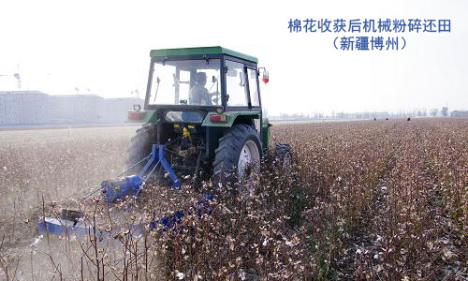Speaking of cotton, what comes to mind must be white cotton wool, flowing and flexible like the white clouds in a fairy tale. Do you know who sustains the beautiful cotton bloom? The stalks of cotton take on this daunting task. But with the advent of autumn, the large and small spitting cotton peaches are picked by hand or harvested by machine, and the hard stalks left behind become a big problem! What should I do?
At first, people adopted a simple and crude method - incineration, but a large amount of smoke produced by incineration caused serious air pollution, and also affected the risk of aircraft take-off and landing, soil environment deterioration, etc. The risk of aggravation, let us have no idea how to use cotton straw, I really want to say "love you" is not easy!
In response to this problem, agricultural scientists have put forward a variety of programs, using the characteristics of cotton straw with high lignin and hard stems, put forward programs for processing plates, energy substances, etc., and then use powerful microbial enzymatic lysis technology to study the crushing of cotton straw and return to the field, decomposition to make cattle and sheep feed and so on. These uses involve a wide range of industries, can be comprehensively selected according to the actual situation, through the promotion and application in recent years, the application effect is good, and the prospects are promising! Because of the diverse uses of cotton straw, we figuratively call cotton straw "The Variable Star King".
Let's tell you how this "Hundred Variable Star King" has changed:
"The first change" - cotton stalks are not afraid of crushing bones, turning into spring mud is more protective of flowers. After the autumn cotton harvest, the cotton stalks are pulled out of the ground and crushed by the machine, thrown on the surface for cover, or the cotton stalks are turned into a depth of 20 cm of the soil by the tiller, and after a winter of decomposition, the cotton stalks will rot into substances rich in organic matter to fertilize the soil. This method is simple and easy to implement, and easy for farmers to accept. Scientists have shown through soil testing that after the cotton stalks are returned to the field, the soil pH tends to be balanced, the nutrients in the soil have increased, the soil organic matter has improved, the water retention and water supply performance is good, in addition, the soil microorganisms we can't see are more abundant, and the number of large soil animals we can see, such as earthworms, has also increased. Of course, everything is not perfect, and there are still some technical problems in returning cotton stalks to the field, such as the slow effect of fertilizing the soil, the lack of professional equipment for returning to the field, which may aggravate crop diseases and insect pests. These also require us to eliminate the drawbacks through technical improvements in the future, but in general, the benefits of crushing cotton stalks and returning them to the field still outweigh the disadvantages.

"Second change" - cotton stalk changes into a cultivation substrate. Cotton stalks can also be used as a substrate for soilless cultivation. First the cotton straw is crushed and piled together for decomposition, and the decomposed cotton stalks are compounded with grass charcoal, vermiculite and perlite, and then adjusted, which can be used as a substrate for soilless cultivation for seedlings, and the seedlings you see serving tomatoes and peppers in the vegetable greenhouse grow in this "warm nest".
The "third change" - cotton stalks into feed. Cotton straw is very rich in nutrients, and tests have shown that cotton straw contains 6.5% crude protein, 44.0% cellulose, 10.7% hemicellulose and 15.2% lignin, and the protein content is higher than that of wheat and corn straw. After the toxic gossypol in cotton straw is treated, it can be made into feed for livestock, which can save breeding costs and increase economic value. However, the treatment of gossypol in cotton stalks needs to be studied together with scientists in animal and botany, biology and nutrition, and scientific and reasonable use schemes are proposed in combination with reality.
The "fourth change" - cotton stalks into fuel. Cotton straw can be used as a raw material for energy production, using cotton straw as a substrate to produce renewable energy sources such as methane or liquid fuels through microbial anaerobic fermentation technology. In addition, the effective pretreatment of cotton straw also has great potential for the preparation of fuel ethanol, and the energy utilization of cotton straw has great potential for development.
The "fifth change" - cotton stalks become wood. Cotton stalks can also replace wood as raw materials for building materials, light industry and textiles. The fiber length and degree of lignification in cotton stalks are about the same as those of wood, which can reduce the use of wood and better fit the concept of turning waste into treasure. After research, it is found that the thermal insulation, decoration and durability of straw wall panels are superior, and can be widely used in various industries to alleviate energy shortages to a certain extent and achieve sustainable development.
In addition to these changes, cotton straw has many functions that are yet to be developed. Just as the so-called "peony flowers are empty and empty, although the jujube flowers are small and fruitful", the seemingly inconspicuous "waste" of cotton straw is actually a veritable "changeable star king". I hope that in the future, we can also develop more uses of cotton straw so that it can realize its own value!